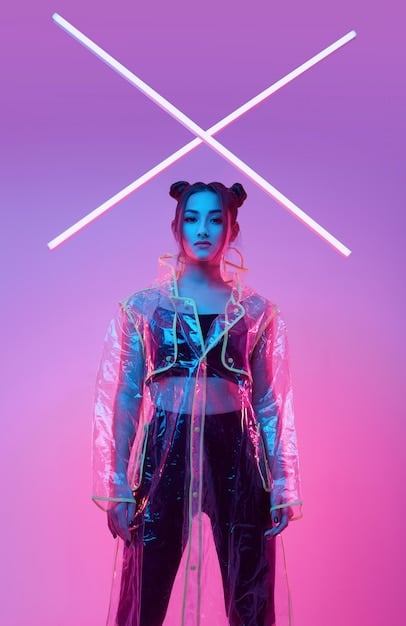Streetwear Influencers: Top Voices Shaping Fashion Today

Exploring the dynamic world of streetwear influencers: the top voices shaping the industry today reveals a powerful convergence of style, culture, and digital prowess that redefines contemporary fashion trends and consumption patterns.
The landscape of modern fashion is constantly evolving, with new trends emerging and old ones being reimagined. Among the most impactful forces driving this change are the streetwear influencers: the top voices shaping the industry today. These individuals, through their unique style and powerful platforms, have not only democratized fashion but have also cultivated a dynamic ecosystem where creativity, authenticity, and community thrive. Their impact goes far beyond mere aesthetics; they represent a significant cultural shift, influencing everything from design philosophies to consumer behavior and market trends. Understanding their role is crucial to grasping the current state and future direction of streetwear.
The Evolution of Streetwear Influence
Streetwear, as a distinct fashion genre, began as a grassroots movement rooted in skateboarding, surf culture, and hip-hop. It was an antithesis to high fashion, emphasizing comfort, utility, and self-expression. Over the decades, it has blossomed into a global phenomenon, bridging the gap between luxury and casual wear. The evolution of its influence is directly intertwined with the rise of digital platforms and social media, which provided an unprecedented stage for individuals to share their style and perspectives, bypassing traditional gatekeepers.
Initially, influence in streetwear stemmed from niche communities and local scenes. Figures like Shawn Stussy, with his eponymous brand, and early hip-hop artists laid the groundwork by embodying an authentic, relatable style. As the internet gained traction, forums and blogs became critical hubs for sharing information and discovering emerging talents. This digital shift was pivotal, allowing for a broader dissemination of ideas and styles, connecting enthusiasts across continents. The democratization of publishing meant that anyone with a unique perspective and an eye for aesthetics could potentially carve out a space for themselves.
From Niche to Mainstream: The Digital Revolution
The dawn of social media platforms like Instagram marked a significant turning point for streetwear. These visual-first platforms were tailor-made for fashion, enabling quick sharing of outfits, product drops, and lifestyle content. Suddenly, individuals could build massive followings by simply showcasing their personal style and documenting their engagement with the culture. This amplified reach transformed local heroes into global icons, making their street style accessible to millions. The rapid feedback loop of likes, comments, and shares created a dynamic environment where trends could form and propagate at an astounding pace.
- Democratization of Fashion: Social media removed many barriers, allowing anyone with a phone and a unique sense of style to become a tastemaker.
- Global Reach: Influencers connected communities worldwide, transcending geographical limitations and fostering a truly global streetwear conversation.
- Direct Engagement: Platforms facilitate direct interaction between influencers and their followers, building loyal communities and authentic connections.
- Trend Acceleration: The speed at which content can be shared has dramatically shortened trend cycles, demanding constant innovation and adaptation.
The digital revolution not only shifted how influence was wielded but also how brands interacted with their audience. Instead of relying solely on traditional advertising, brands began to recognize the power of collaborations with these emerging voices. This symbiotic relationship saw influencers gaining access to exclusive products and opportunities, while brands benefited from organic reach and authentic endorsement from trusted figures. This era redefined celebrity, giving rise to a new type of fashion icon whose credibility was built on their genuine passion and connection to the culture rather than traditional fame.

As streetwear moved further into the mainstream consciousness, its influencers diversified their appeal, moving beyond just outfit posts. Many began to leverage their platforms for entrepreneurship, launching their own brands, curating events, and even consulting for major fashion houses. This evolution highlights a maturity in the influencer landscape, where pioneers have transitioned from mere content creators to multifaceted business entities, cementing their long-term impact on the industry. The journey from niche enthusiast to industry titan is a testament to the transformative power of authentic passion combined with strategic digital savviness.
Key Characteristics of Influential Streetwear Voices
What defines a truly influential voice in the streetwear world? It’s more than just having a large following. Authenticity, an unparalleled sense of style, and a deep understanding of the culture are paramount. These characteristics allow influencers to resonate deeply with their audience, fostering trust and loyalty that transcend fleeting trends. Their ability to consistently deliver high-value content that educates, inspires, and entertains is crucial for sustained impact within this dynamic industry.
A strong personal brand is foundational. Influencers often cultivate a distinct aesthetic and personality that sets them apart. This could be a unique approach to layering, an affinity for rare vintage pieces, or an emphasis on sustainability within streetwear. This personal signature makes their content instantly recognizable and ensures their voice stands out in a crowded digital space. Furthermore, their narratives often extend beyond just clothing, touching upon broader lifestyle themes, art, music, and social issues, reinforcing their multi-dimensional appeal.
Authenticity and Cultural Knowledge
One of the most critical elements of a successful streetwear influencer is their authenticity. The community can quickly spot fakes or those merely chasing trends for commercial gain. True influencers emerge from a genuine love for the culture, often having been deeply embedded in it for years. This translates into content that feels honest, relatable, and informed. They understand the history, the nuances, and the unspoken rules of streetwear, which allows them to offer insights that resonate with true enthusiasts and newcomers alike.
- Genuine Passion: Their love for streetwear is evident in their content, fostering trust and relatability with their audience.
- Deep Dive into Culture: Beyond just outfits, they explore the roots of streetwear in music, art, sports, and social movements.
- Curatorial Eye: They possess a unique ability to discover upcoming brands, spot nascent trends, and reinterpret classics.
- Credibility: Their long-standing engagement with the culture lends their opinions significant weight and respect within the community.
Beyond authenticity, a keen eye for trends, design, and product is essential. Influencers are often trendsetters themselves, with an innate ability to predict what’s next or to popularize obscure items. They act as arbiters of taste, guiding their followers on what to watch out for, what to invest in, and how to style pieces in novel ways. This curatorial skill is highly valued, as it saves their audience time and effort in navigating the ever-expanding world of streetwear, providing a curated lens through which to view the industry.
Finally, community engagement is a hallmark of influential voices. They don’t just broadcast; they interact. Responding to comments, hosting Q&As, and fostering discussions create a loyal and active following. This two-way communication builds a sense of belonging among their audience, transforming passive viewers into active participants in the streetwear conversation. This symbiotic relationship ensures that their influence is not merely transactional but built on a strong, engaged foundation, cementing their role as community leaders.
The Impact on Brands and Retail
The influence of streetwear personalities extends deeply into the operational strategies of brands and the retail landscape. Gone are the days when traditional advertising was the sole driver of sales. Today, an endorsement from a respected influencer can ignite demand, sell out collections, and even dictate future production runs. This powerful form of organic marketing is often more effective than traditional methods because it comes from a trusted source, resonating with a demographic that values authenticity over overt commercialism.
Brands now actively seek out collaborations with top streetwear influencers, recognizing the immense value they bring. These collaborations can range from simple product placements to jointly designed collections that leverage the influencer’s unique aesthetic and reach. Such partnerships are mutually beneficial; influencers gain credibility and access to larger platforms, while brands tap into highly engaged audiences and gain insights into evolving consumer preferences. This shift has reshaped marketing budgets, with significant allocations moving towards influencer partnerships and content creation.
Shifting Retail Paradigms: Drops and Exclusivity
Influencers have played a crucial role in popularizing the “drop” model, a core retail strategy in streetwear. By building hype through their channels, teasing new releases, and providing early access or exclusive peeks, they create intense anticipation leading up to a product launch. This strategy taps into the fear of missing out (FOMO) and the desire for exclusivity, leading to rapid sell-outs and increased brand desirability. The scarcity model, propagated heavily by influencer hype, has transformed consumer buying habits within the segment.
- Hype Generation: Influencers are masters at building anticipation for new releases, turning product launches into cultural events.
- Exclusive Access: Providing followers with early links or special codes drives immediate sales and fosters loyalty.
- Product Placement: Organic integration of new items into their content showcases products in a natural, aspirational context.
- Trend Validation: When an influencer wears or endorses a product, it often becomes an instant must-have, validating its place in the market.
Beyond affecting individual product sales, influencers also shape broader retail trends. Their coverage of specific brands, forgotten archives, or emerging designers can bring niche labels into the spotlight, fostering the growth of independent businesses. They act as informal market researchers, providing brands with invaluable feedback based on audience engagement and preferences. This direct line to consumer sentiment allows brands to adapt quickly, iterate on designs, and stay relevant in a fast-paced market.
The symbiotic relationship between influencers and retailers has also given rise to new retail concepts, such as curated online marketplaces and pop-up shops heavily promoted by influencers. These initiatives often leverage the influencer’s personal brand and curatorial expertise to create unique shopping experiences. Consequently, the retail landscape for streetwear is continuously evolving, driven by the dynamic interplay between content, community, and commerce—all heavily facilitated by the influential voices leading the charge.
Spotlight on Prominent Streetwear Influencers
Within the vast universe of streetwear, certain individuals have risen to prominence, not just for their personal style but for their significant contributions to the culture. These are the voices whose content shapes narratives, ignites trends, and pushes the boundaries of what streetwear can be. Their methodologies vary, from the intricate documentation of fashion history to the bold experimentation with new aesthetics, but all share a common thread of genuine passion and an undeniable impact on the industry.
Consider figures like Highsnobiety’s editorial team and influencers who have built entire media empires around streetwear. Their influence stems from their ability to consistently deliver high-quality, insightful content that goes beyond mere product showcases. They delve into the stories behind the brands, the cultural significances of specific pieces, and the broader socio-economic contexts that shape fashion. This depth of content positions them as authorities, making their endorsements and analyses highly respected within the community.
Creators Defining Today’s Streetwear Landscape
There are numerous individuals who consistently set the bar for influence. From artists to designers, their impact spans varied aspects of the industry. Many have cultivated massive Instagram followings, acting as daily sources of inspiration for millions. Others have leveraged their platforms to launch successful brands, becoming entrepreneurs who directly contribute to the supply side of the industry. Their personal journeys often serve as compelling narratives, illustrating the potential for self-made success within the creative economy.
- Digital Tastemakers: Individuals who leverage platforms like Instagram and TikTok to showcase their unique styles and predict upcoming trends.
- Brand Founders: Influencers who have parlayed their personal brand and aesthetic into successful streetwear labels.
- Content Curators: Those who specialize in producing engaging visual content, from professional lookbooks to candid daily outfits.
- Cultural Commentators: Influencers who provide critical analysis, historical context, and commentary on the state of streetwear and its connection to broader culture.
Beyond individual style, many influential figures are celebrated for their commitment to innovation and community building. Some actively promote sustainability within streetwear, advocating for ethical production and consumption practices. Others focus on highlighting emerging talents from underrepresented communities, using their platform to amplify diverse voices and foster inclusivity. This broadened scope of influence demonstrates a growing maturity in the streetwear space, where leaders are expected to contribute beyond just fashion aesthetics, embracing social responsibility.
Ultimately, the most prominent streetwear influencers are those who adapt and evolve with the changing tides of fashion and technology. They understand that their audience craves novelty but also authenticity. By consistently delivering both, they maintain their relevance and continue to shape the industry, ensuring that streetwear remains at the forefront of contemporary style and cultural expression. Their ability to remain relatable while pushing boundaries is a key factor in their enduring appeal and sustained impact.
Challenges and Criticisms Facing Influencers
Despite their pervasive influence and undeniable success, streetwear influencers face a range of challenges and criticisms. The very platforms that propelled them to fame also present dilemmas, from the pressure to maintain authenticity in commercialized spaces to the constant demand for fresh content. Navigating the delicate balance between personal expression and brand partnerships is a perpetual tightrope walk, as missteps can quickly erode trust and standing within the community.
One significant challenge is the intense competition and the saturation of the influencer market. With so many individuals vying for attention, it becomes increasingly difficult to stand out and maintain unique appeal. This often leads to a constant need for innovation in content creation, pushing influencers to experiment with new formats, aesthetics, and narratives. The relentless pace can lead to burnout, and the pressure to remain relevant sometimes compromises the authenticity that initially drew followers in.
Maintaining Authenticity in Commercialized Spaces
The line between genuine passion and commercial interest can become blurred when lucrative brand deals enter the picture. Followers are highly attuned to inauthenticity, and overly sponsored content that doesn’t align with an influencer’s established style or values can be met with skepticism and backlash. Influencers must meticulously vet partnerships to ensure they resonate with their personal brand and audience expectations.
- Sponsorship Transparency: The ethical imperative to disclose sponsored content is a constant discussion, impacting trust if not handled correctly.
- Creative Fatigue: The demand for consistent, high-quality, and innovative content can lead to creative blocks and burnout.
- Community Backlash: Perceived inauthenticity or purely commercial motives can lead to swift and severe negative reactions from their audience.
- Algorithm Dependence: Changes in platform algorithms can significantly impact reach and engagement, forcing constant adaptation and strategic shifts.
Another area of criticism revolves around the environmental impact of fast fashion consumption, which influencers can inadvertently promote through constant product showcasing. As awareness about sustainability grows, influencers are increasingly scrutinized for their role in encouraging rapid consumption cycles. Many are now attempting to address this by promoting vintage finds, sustainable brands, or advocating for more conscious consumption habits, reflecting a growing sense of responsibility within the community.
Furthermore, the pressure to conform to popular trends or to chase virality can lead to a homogenization of content, where unique voices are diluted in an effort to appeal to a wider audience. This diminishes the very authentic and original spirit that streetwear was founded upon. Addressing these criticisms requires influencers to be self-aware, adaptable, and committed to their core values, continuously striving to balance commercial success with cultural integrity and genuine community connection.
The Future Landscape of Streetwear Influence
The realm of streetwear influence is poised for continuous evolution, driven by technological advancements, shifting consumer values, and the emergence of new platforms. The established paradigms of content creation and community engagement are constantly being challenged and redefined, pushing influencers to innovate and adapt at an unprecedented pace. Understanding these emerging trends is crucial for anyone looking to navigate or contribute to the future of streetwear culture.
One significant trend is the rise of diversified content formats beyond traditional photo posts. Video-first platforms like TikTok are increasingly dominant, demanding more dynamic and engaging narratives. Live streaming, interactive experiences, and even virtual reality showrooms are becoming avenues for influencers to connect with their audience in more immersive ways. This push towards multi-sensory content promises to make the connection between influencer and follower even more profound and interactive.
Emerging Platforms and New Forms of Engagement
While Instagram remains a stronghold, the landscape is broadening. New social media platforms, or niche, community-driven apps, could rise to prominence, offering different ways for influencers to connect with their audience. The metaverse, with its promise of virtual fashion and digital identities, presents an entirely new frontier for streetwear influence, where digital outfits and avatars become the new canvas for self-expression.
- Metaverse Fashion: Digital clothing and accessories will offer new avenues for style expression and influencer collaboration.
- AI-Powered Content: Influencers may leverage AI tools for content creation, from generating specific visuals to personalized style recommendations.
- Hyper-Niche Communities: A move towards smaller, highly engaged communities focused on very specific aesthetics or interests.
- Direct-to-Consumer (DTC) Brands: More influencers will launch their own DTC brands, bypassing traditional retail channels entirely.

Furthermore, there’s an increasing emphasis on hyper-personalization and direct engagement. Influencers might leverage AI and data analytics to offer tailored styling advice or product recommendations to their followers. The direct feedback loop between audience and creator will become even tighter, allowing for more responsive content creation and community building. This level of intimacy and customization will solidify the bond between influencers and their most loyal fans.
The future will also likely see a continued integration of streetwear, technology, and social responsibility. Influencers will increasingly be expected to not only showcase style but also to champion causes, from environmental sustainability to social justice. Their platforms will evolve into spaces for education and advocacy, demonstrating fashion’s capacity to be a powerful force for positive change. This expanded role will solidify their position not just as style icons but as cultural leaders. The adaptability and foresight of these voices will determine who continues to shape the industry in the decades to come.
How Aspiring Influencers Can Make Their Mark
For those aspiring to join the ranks of influential streetwear voices, the path is challenging but navigable. It requires a combination of genuine passion, strategic thinking, and relentless dedication. Simply copying what others are doing is no longer enough; authenticity and a unique perspective are paramount. The crowded nature of the digital space means that standing out requires more than just good style; it demands a compelling narrative and a consistent commitment to quality.
The first step is to cultivate an authentic personal style that genuinely reflects who you are. This isn’t about chasing every trend but about developing a signature aesthetic that is distinctive and recognizable. Your style should be a true extension of your personality and values. Once this core identity is established, consistency in content creation is key. Regular posts, engaging captions, and high-quality visuals are essential for building and maintaining an audience.
Key Steps to Cultivating Influence
Building a significant presence in the streetwear sphere involves a multi-faceted approach. Beyond personal style, it requires understanding your audience, engaging with the community, and leveraging digital tools effectively. Networking with other creators, attending industry events (both digital and physical), and staying informed about emerging trends are all crucial elements of growth.
- Find Your Niche: Identify a unique angle or aesthetic that differentiates your content from others.
- Consistent High-Quality Content: Produce visually appealing and engaging content regularly, whether it’s photos, videos, or written pieces.
- Engage Your Audience: Respond to comments, ask questions, and foster a sense of community among your followers.
- Network and Collaborate: Connect with other creators and brands to expand your reach and learn from shared experiences.
- Understand Analytics: Use data to understand what content performs best and tailor your strategy accordingly.
- Stay Authentic: Remain true to your personal style and values, especially when considering brand partnerships.
Understanding your target audience is also critical. What do they care about? What kind of content resonates with them? Tailoring your messaging and content style to their preferences will significantly enhance your engagement. Furthermore, embracing experimentation is vital. The digital landscape is constantly changing, so being open to trying new platforms, content formats, and creative approaches will keep your work fresh and relevant. The ability to adapt and learn is a hallmark of successful influencers.
Finally, patience and perseverance are indispensable. Building a strong, genuine influence takes time and effort. There will be setbacks and slow periods, but those who are truly passionate and committed to their vision will ultimately succeed in carving out their valuable space within the ever-expanding world of streetwear, contributing their unique voice to the ongoing cultural conversation.
| Key Point | Brief Description |
|---|---|
| 🚀 Evolving Influence | Streetwear influence shifted from niche to global via digital platforms, democratizing fashion. |
| ✨ Authentic Style | Top influencers embody genuine passion and deep cultural knowledge, setting trends. |
| 📈 Brand Impact | Influencers drive sales via collabs and hype drops, reshaping retail and marketing. |
| 💡 Future Trends | New tech like metaverse, AI, and niche communities will shape streetwear’s next era. |
Frequently Asked Questions About Streetwear Influencers
While specific names fluctuate with trends, top streetwear influencers typically include figures like Luka Sabbat, Kerwin Frost, and Bloody Osiris, as well as editorial platforms like Highsnobiety and Hypebeast, whose content teams wield immense influence. These individuals and entities continually showcase cutting-edge styles, collaborate with major brands, and redefine cultural narratives within the fashion space, pushing boundaries and setting new benchmarks for style.
Streetwear influencers wield significant impact by showcasing new products, creating outfit combinations, and collaborating with brands. Their authentic endorsements and early access to coveted items generate immense hype, often leading to rapid sell-outs of collections. They effectively bridge the gap between niche subcultures and mainstream fashion, accelerating trend adoption and influencing consumer purchasing decisions through their widespread digital reach and trusted opinions.
Instagram remains a primary platform for visual content and community building due to its strong emphasis on imagery and stories. TikTok has rapidly grown in importance for its short-form video capabilities and algorithm-driven discoverability, reaching younger audiences. YouTube is crucial for deeper content like hauls, reviews, and vlogs, while platforms like Twitter or niche forums facilitate discussion and direct interaction within the core enthusiast community around various product drops and events.
Yes, theoretically anyone can become a streetwear influencer, but success requires authenticity, a unique personal style, and consistent effort. Building influence demands a genuine passion for the culture, a keen eye for aesthetics, and the ability to create engaging, high-quality content. It also involves community engagement, understanding digital platforms, and a willingness to adapt, as the industry values originality and real connection over superficial trends or generic content.
Streetwear influencers frequently face challenges such as maintaining authenticity amidst commercial partnerships, battling content saturation in a competitive market, and keeping up with rapidly changing trends and platform algorithms. There’s also the pressure to create fresh, innovative content constantly, and the risk of community backlash if transparency or perceived values are compromised. Sustainability concerns and ethical consumption are also growing areas of scrutiny for influencers today.
Conclusion
The role of streetwear influencers: the top voices shaping the industry today cannot be overstated. From their roots in subcultures to their current status as global tastemakers, these individuals have fundamentally transformed how fashion is perceived, consumed, and disseminated. Their authenticity, distinctive style, and profound cultural understanding empower them to drive trends, cultivate communities, and influence market dynamics on an unprecedented scale. While navigating challenges like commercialization and content saturation, their ability to adapt and innovate ensures their continued relevance. As technology evolves and new platforms emerge, streetwear influencers will undoubtedly remain at the forefront, continually redefining the intersection of style, culture, and digital engagement, solidifying their enduring impact on the fashion world for years to come.





